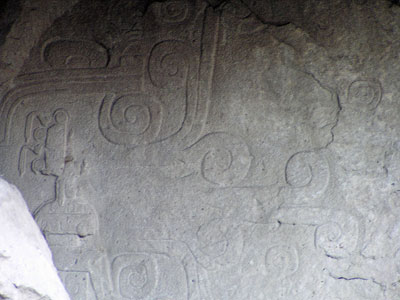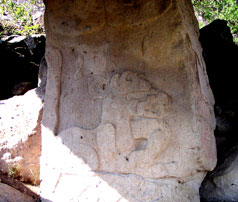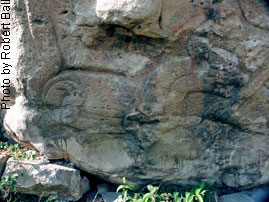Chalcatzingo 1500 BCE-present Olmec florescence: 700-500 BCE
People lived at Chalcatzingo before the Olmecs, long before, in fact. But the visible remains today are the result of Olmec influence and habitation that peaked between 700 and 500 BCE. The Olmecs were a people of the Gulf Coast plain, a hot swampy region, who apparently early on began to trade with the inhabitants of the central highlands, where they left a most significant mark at Chalcatzingo.
"Chalcatzingo," Nahuatl in origin, is variously taken to mean "the Chalcas' most precious site," "the revered site of the sacred water," and "the revered site of precious jade stones." I suppose you may take your choice.
The settlement is situated at the base of three outcroppings of lava, which tower over the surrounding agricultural land, that were considered sacred not only by the Olmecs but also by the Aztecs and even by modern peoples. On the slopes beneath these isolated intrusions Olmec artists carved complex scenes of mythological and, in some cases (perhaps) historical events. |
 |
 |
One of the scenes that combines mythological and presumably historical themes depicts a female ruler (M. Coe), wearing an elaborate headdress and holding in her arms a ceremonial bar, seated in a cave, which is the mouth of some sort of monster that emits smoke or steam. It's necessary to allow one's mind's eye to fill in the curvature of the monster's mouth due to the stone that, unfortunately, obscures its details at lower left in the photograph. Click here for a closeup.
Not solely the responsibility of obscuring boulders is the necessity to imagine clouds above the image from which fall what Michael Coe called "phallic raindrops. The woman must have been a ruler of Chalcatzingo, and the theme is one of power and fertility." |
 |
 The jaguar was the god of the Olmecs. Was it worshiped at this altar where the remains of a child were found? |
 |
